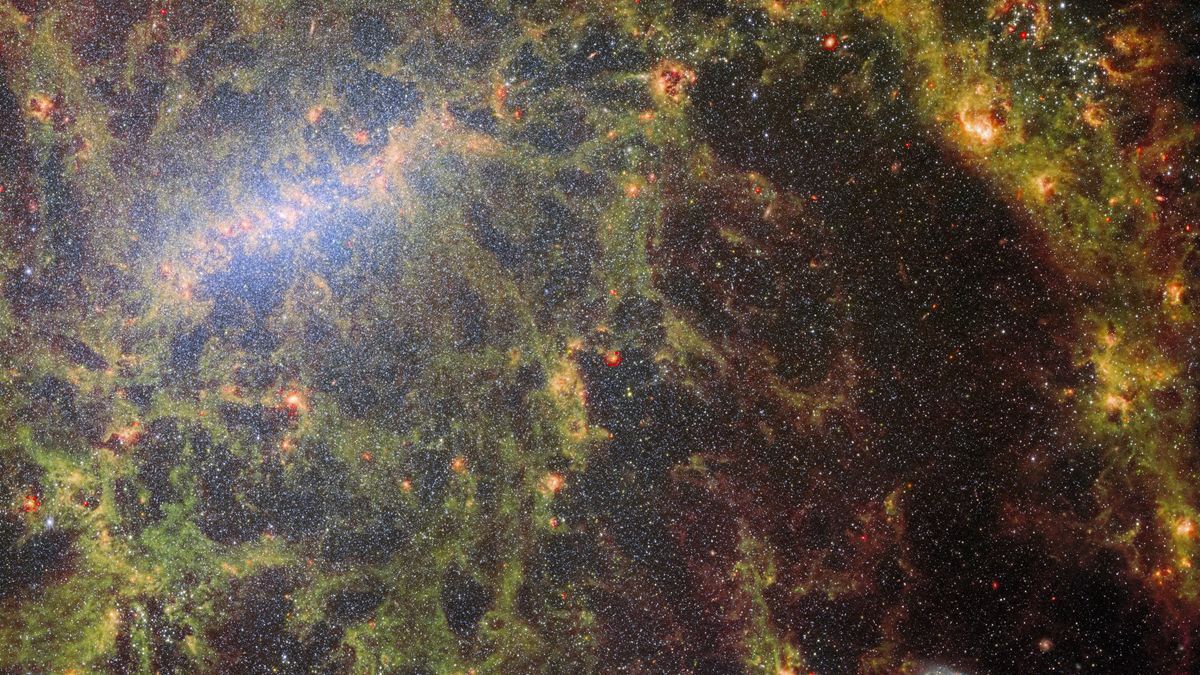
The James Webb Space Telescope (JWST) has captured a stunning image of a distant spiral galaxy as astronomers aim to study the birth of stars in the deeper regions of space.
JWST has spotted the galaxy NGC 5068, located 17 million light-years away in the constellation Virgo, as part of its mission to build what the European Space Agency (ESA) calls “treasure trove” From observations of star formation in relatively nearby galaxies.
This repository could help scientists better understand the processes of star formation, and thus how barred spiral galaxies like our own Milky Way evolve.
Related: James Webb Space Telescope (JWST) – Complete Guide
This image of NGC 5068 shows tendrils of gas and stars extending throughout the barred spiral galaxy. The galaxy’s dense and bright central band, which distinguishes it from “unbarred” spiral galaxies, can be seen in the upper left corner of the image.
These large central bars are not solid bodies but are instead made of tightly packed stars, and the stellar bars that galaxies like NGC 5068 possess may indicate that they are older and more evolved than the unbarred spiral galaxies. This is because these structures are believed to take about two billion years to form.
As this bar of stars rotates, astronomers think it may be drawing gas and dust into the center of these galaxies, where it acts as fuel for intense explosions of star formation. The plume action in NGC 5068 appears to be causing the stars to form in spirals. These dense clouds of gas and dust that collapse to form stars also block out visible light, making it difficult to study dim star-forming regions, at least in the visible-light wavelengths of the electromagnetic spectrum.

JWST is the perfect instrument for peering through these clouds because infrared light passes through dust and gas mostly unimpeded, and the powerful space telescope launched on Christmas Day in 2021 is designed to see the universe in infrared.
This image of NGC 5068, a galaxy at least 45,000 light-years in diameter that can be seen head-on from Earth, was created using two of JWST’s primary instruments—the Mid-Infrared Instrument (MIRI) and the Near Infrared Spectroradiometer (NIRSpec) Both are compatible with different wavelengths of infrared light.
So far, JWST has collected images of 19 relatively nearby star-born galaxies, which astronomers should be able to combine with a wealth of observations from space telescopes and other ground-based observatories to better understand star formation. These include Hubble Space Telescope images of more than 10,000 star clusters, spectral mapping of about 20,000 clusters, observations of star-forming emission nebulae from the Very Large Telescope (VLT) and imaging of 12,000 dark, dense molecular clouds identified by the Atacama Large Millimeter. / millimeter array (ALMA).
Taken together, these observations give astronomers a picture across a wide spread of the electromagnetic spectrum, which may detail star formation properties.




More Stories
Boeing May Not Be Able to Operate Starliner Before Space Station Is Destroyed
Prehistoric sea cow eaten by crocodile and shark, fossils say
UNC student to become youngest woman to cross space on Blue Origin